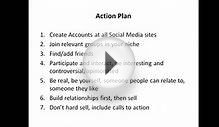
Have you learned how to use Twitter and Facebook? If so, you’ve qualified to call yourself a consultant.
Now that you know how to use Twitter and Facebook, you can use it to build your social media business. But first, you need proof that you rock. You need to show your potential clients you know what you’re doing.
- You should start a blog and write at least once a week. (Only write about the success of your business)
How do you do all that? Just go out there and start following and friending as many people as you can. Tell them all you’re a consultant. Eventually, one of them will be dumb enough to give you some money to do the same for them.
Seriously – I am followed on Twitter by at least 2 ‘Social Media Consultants’ a DAY. If I don’t follow them back I am un-followed soon after. These people learned ‘How To Become a Social Media Consultant’ by taking someones $2, 000 course. They’re following a system and they’re just muddying up the aspects that actually make Social Media so effective.
These Social Media Consultants ‘proof’ is only around how they’re building their OWN business using the tactics and strategies they learned. Most haven’t done a single thing for any other business but their own.
So here’s how to REALLY become a Social Media Consultant
I want you to first ask yourself WHY you’re contemplating becoming a professional in the Social Media Consulting business. The challenges are plenty. To do it effectively and with integrity – you need to put in time and effort in the beginning, like any other business worth doing.
Still want to do this? Ready to build a Social Media Consulting Business? Okay, here goes!
12 Steps to Becoming an Effective (and Awesome) Social Media Consultant
1 – Find a family member or friend who could use some help getting started in the Social Media realm
- Pick someone who doesn’t have a business. Just someone who will use it for personal use.
- Help them get interested in something they love. Movie Buff? Get them involved in the Film Scene.
- Offer to do it with them for free. (You’re working WITH people, not FOR people)
- Get used to doing the steps you took for yourself, for someone else.
- Keep a journal about what it’s like to do this with someone that isn’t you.
- Highlight the points that you realize you’ll deal with each and every time.
- Do this with as many people as you can.
2 – Now pick a family member or friend with a business
- You’re now going to help someone use Social Media professionally.
- Again, you’re going to offer to do this for free. You’re just learning this stuff, and this is the best way to learn.
- Let them know you’ve never done this professionally, and that they know their business better than you do.
- You’ll discover quickly how personal use of Social Media is different from professional and corporate use.
3 – Map out a path to Social Media success
- I can’t teach you this, this has to come from within you
- This is the part that you need to be AMAZING at. This is where it’s going to be hard before it gets easy.
- Keep In Mind: You want to find out what their customer funnel is. How do they go from no lead to a lead to a sale?
- Try thinking about it as a potential customer of theirs as much as possible.
- Be prepared for strong objections to ideas you have – this is all very new to them!
- It’s new to you too! In the beginning, you’re not the expert. Let some things go – don’t be stubborn.
4 – Communicate Efficiently
- You need to be clear and concise every step of the way.
- If you have questions that need answered – make it easy for them to answer them.
- In email I re-state my questions at the end in point form, and I say ‘AnswerThese’.
- Whenever you get anything new ready – get it approved BEFORE making it ‘live’.
- Ask lots of questions.
- Answer lots of questions.
5 – Track all your time spent
- Discovering how long tasks take you is key to turning this into a business.
- Pinpoint places that seem to be taking longer than they should be (Too long in face to face meetings).
- You can go simple by just watching the clock.
- Or you can use desktop widgets, time-tracking systems and invoicing software.
6 – Keep a Journal
- You need to write down what is working and what isn’t.
- Write out the processes and steps you take to complete all tasks.
- Make note of what aspects seem especially hard for the business to overcome (Writing Blog Posts? Responding to Inquiries on Twitter?)
- Keep a page that is ONLY for writing what you are LOVING about doing this.
INTERESTING VIDEO














